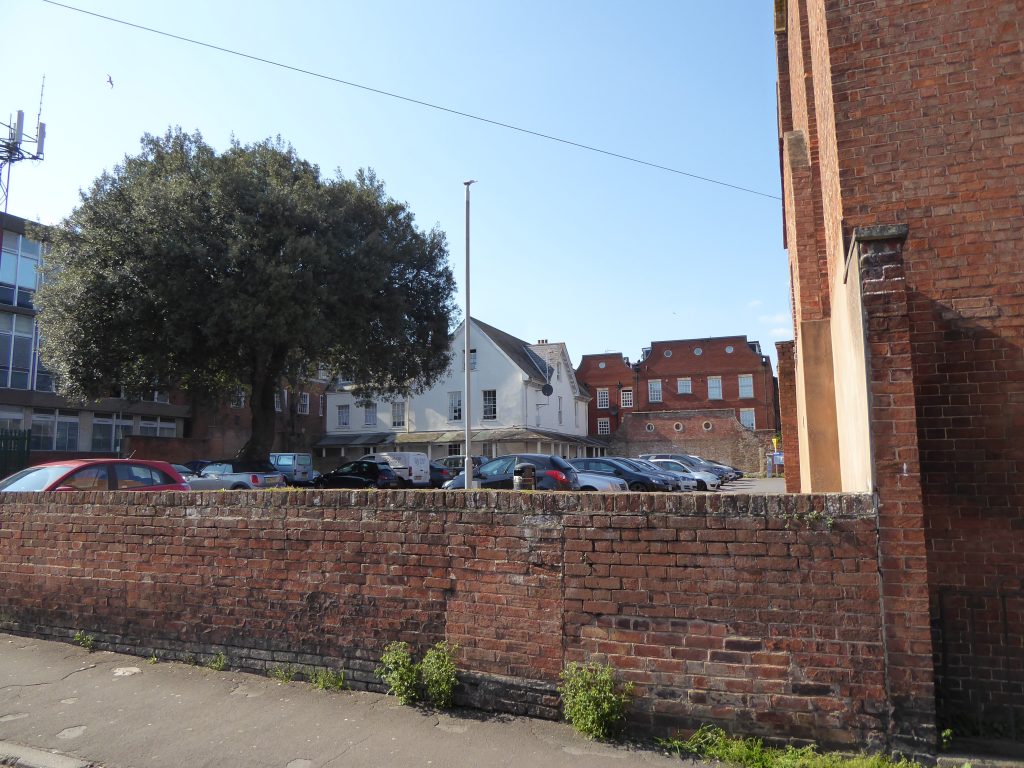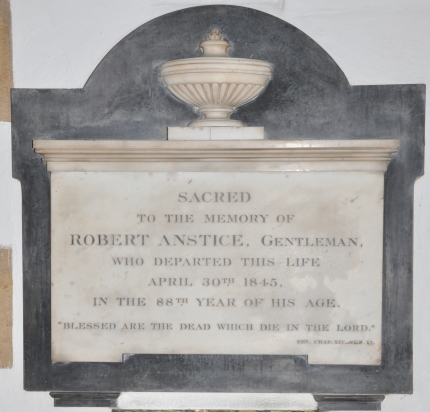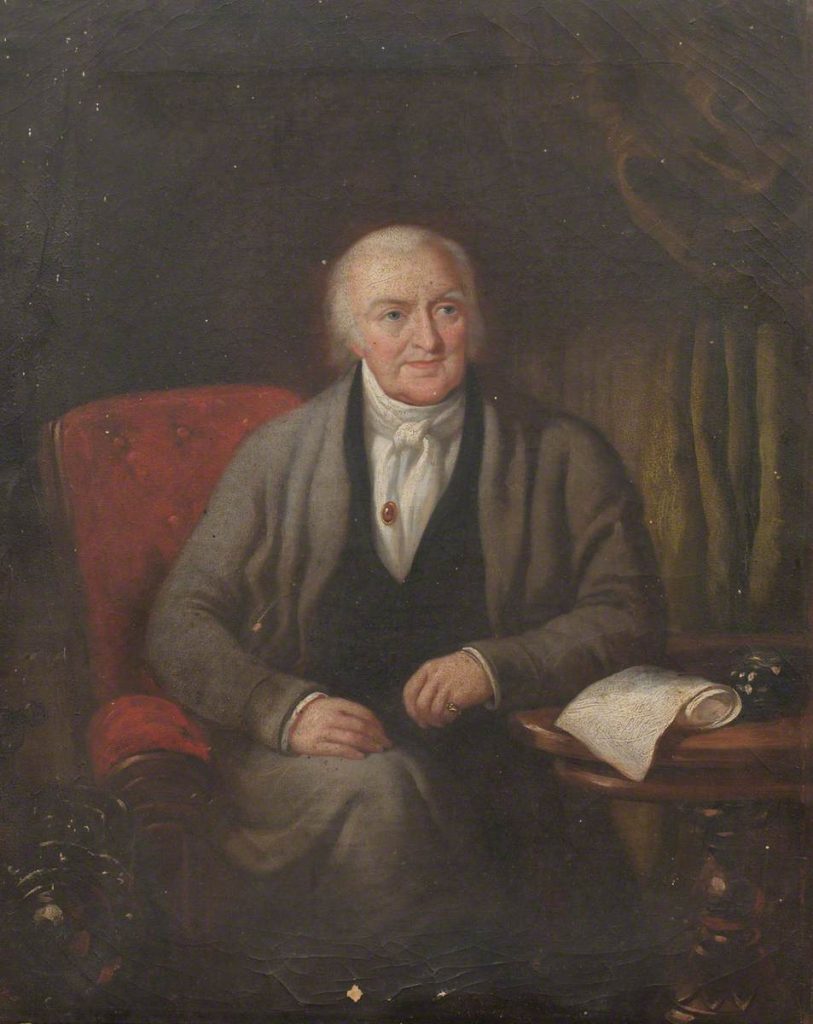ROBERT ANSTICE was a ship-owner and merchant, civil engineer and Somerset’s first County Surveyor. He was baptised at St Mary’s Bridgwater on 9 December 1757, and died 30 April 1845 at Madeley, Shropshire, aged 88 (although the newspapers reported Bridgwater). His body was buried inside St Mary’s Church on 7 May 1845.
Anstice was the son of William and Mary Anstice. In c1788 Robert eloped to Gretna with Susannah Ball, a Bridgwater Quaker girl. He was a brother in law of William Reynolds, William Reynolds (1758 – 1803) was an English ironmaster and a partner in the ironworks in Coalbrookdale in Shropshire. After Reynold’s death in 1803, one of the eight children of Robert and Susannah, also William, took over the running of the Madelely Wood or Bedlam Ironworks, near Coalbrookdale from his uncle.
Robert Anstice followed his father as a ship-owner and merchant, and later took over his brother-in law’s share of the Coalport China Works.
He lived at first in a house near the Town Bridge (later the site of the Roman Catholic Chapel), facing the river, and latterly moved to Dampiet House.

He was Comptroller of Customs by 1794, Town Councillor from 1799-1834, and Mayor in 1804, 1817 and 1825. He was Alderman from 1827. He was a member of the Commission for Sewers, the body responsible for drainage questions on the Levels. He was an active anti-slavery reformer and was a Freemason.
He was a keen amateur geologist and ornithologist, and wrote two books on mathematics. He was elected a Fellow of the Geological Society in 1818. His correspondence on ornithology with Col. George Montagu was published in 2003.
His professional work in the county covered roads and bridges, sea-wall work at Huntspill and Blue Anchor, and much drainage works, including Kings Sedgemoor Drain at Dunball. He was involved in the design of a proposed waterworks for the town located at Saint Matthews’ field that pumped water from the Durleigh Brook to a reservoir nearby.
Anstice purchased a hoard of Roman artefacts discovered at Edington in 1801, and also acquired a number of Roman coin moulds, discovered near Chilton Polden, which he displayed in his ‘museum at Bridgwater’.
On his death his collection was sold by Sotheby’s in 1846, but, according to Jarman his fossils were sold to the Bridgwater Literary and Scientific Institution. Some of his antiquarian collection was acquired by the British Museum
His astronomical clock made for him by John Cole of Nether Stowey may be seen in the Museum of Somerset.
April 30, at Bridgwater, in the 88th year of his age, Robert Anstice, Esq., a most highly esteemed and respected inhabitant of Bridgwater, whose extensive information and solid understanding, united to ardent piety, and the most unaffected benignity and humility of mind, rendered the privilege of his friendship and connection inestimable, and his loss irreparable to those who enjoyed that privilege.
Sherborne Mercury 10 May 1845
April 30, at Bridgwater, aged 88, Robert Anstice, Esq., member of several learned societies. His scientific acquirements were as highly appreciated by the most distinguished men of the age, as his benignity and Christian temper were by his friends and more immediate connexions. Until within a few days of his death his capacious intellect and memory were as vigorous and unclouded as at any period of his estimable life.
Bath Chronicle, 8 May 1845

Portrait
There is a portrait of him in the collection of the Pembrookshire County Museum at Scolton Manor Museum, Haverfordwest:

The portrait was first catalogued in 1977, but there is no information about where it came from or why it is in the collection. It is similar to a portrait miniature in the hands of the family. See page 12 of this document.
During the 1950s and 1960s the then County Librarian at Haverfordwest started to collect items of historical interest which went on to form the nucleus of the County Museum, which finally opened in the 1970s. Formal cataloguing of the County Museum collection did not begin until 1977, when this painting was catalogued and listed under its present title. It is probable that the portrait came into the collection during the period before form cataloguing took place and no information was found about it when it was finally catalogued.
The Anstice family’s association with Blists Hill, Madeley, Shropshire began in the late 18th century when William Anstice (1781 – 1850) moved to the area. William began working with his uncle William Reynolds (1758 – 1803), the owner of the Madeley Wood Company. They worked together until Reynolds’ death, after which William Anstice took full ownership of the Madeley Wood Company. He went on to establish the blast furnaces and brickworks at Blists Hill, as well as several more mines in the Madeley area. At its peak the company employed about one thousand people. When William died in 1850, his son John Anstice (1810 – 1867) took ownership of the company.
As well as being industrialists, the Anstice family were important local philanthropists. They were responsible for building a school and mission room at The Lloyds in 1852, and were known to pay the funeral expenses of their employees who died while at work. John Anstice was well respected by his workers, and following his death in 1867 a memorial fund was established in his name. This fund, along with money donated by the Anstice family, paid for the building of the Anstice Memorial Hall in Madeley. The Hall was opened in 1870 and became a place for entertainment, education and socialising for local people.
Following John Anstice’s death, his sons John and Richard, along with his brother William, took over the management of the company. William died in 1881 and his nephews continued the business until 1918, when they sold the company.
Originally Blists Hill was an industrial region consisting of a brick and tile works, blast furnaces and coal, iron and fire clay mines. Blists Hill Victorian Town is now an open-air museum built on a former industrial complex located in the Madeley area of Telford, Shropshire, England. The museum attempts to recreate the sights, sounds and smells of a Victorian Shropshire town in the late 19th and early 20th centuries. It is one of ten museums operated by the Ironbridge Gorge Museum Trust. The museum was opened in 1973 and has been growing ever since. The museum’s buildings fall into one of three categories, buildings that were already part of the industrial site, buildings that represent a generic type and original buildings that have been relocated to the museum.
See the British Museum Collection here.
Family Tree at Geneanet.
Books
Remarks on the Comparative Advantages of Wheel Carriages of different structure and draught. by Robert Anstice, Publisher: Bridgewater : The Author, 1790.
An enquiry into the laws of falling bodies, etc, by Robert Anstice, Publisher: London : Printed for J. and A. Arch, 1794
Catalogue of the Collection of English Coins and Medals, of the late Robert Anstice, Esq. ... : 20 March 1846 Publisher: London: Sotheby, [1846]
Anstice (Robert, F.G.S.) Catalogue of a Collection of Antiquities, Shells, Minerals and Fossils, and objects of Art, formed by the late R. Anstice, F.G.S., of Bridgewater ; to which are added many miscellaneous articles of antiquarian interest. Sold Sothebys, March 23rd, 1846. 8vo. Lond.
Published Sources
David Greenfield, in Biographical Dictionary of Civil Engineers, Vol 1, 2002, pp 17-18
S. P. Dance, Letters on ornithology 1804-1815 between George Montagu and Robert Anstice, 2003, G. G. Books, Wigtown.
W Phelps, The History and Antiquities of Somersetshire, four volumes, 1835.
H S Torrens, ‘The Reynolds-Anstice Shropshire geological collection – 200 years of history and its lessons’, in Wheeler, A. & Price, J.H. (eds.). History in the service of systematics Papers from the conference to celebrate the Centenary of the British Museum (Natural History), 13-16 April 1981. Society for the Bibliography of Natural History Special Publication, 37-41, 1981.
H S Torrens, ‘The Reynolds-Anstice Shropshire geological collection – 1776-1981’, Archives of Natural History, 10, 429-441, 1982
Archive Sources
Prof Hugh Torrens’s research notes on the family in Shropshire Record Office
A number of papers relating to Anstice and William Baker (see below) are in the British Library.
British Library Spencer George Perceval Collection Add. Mss. 35173
Anstice (Marcia). Letter to W. Baker 1845. Add. 35173 f. 283
Anstice (Robert). of Bridgwater, F.G.S. Correspondence with W. Baker 1823-1843.Add. 35173 ff. 17-265 passim
Anstice (Robert). of Bridgwater, F.G.S. Obituary notices 1845. Add. 35173 ff. 288, 290, 291
Anstice (Robert). of Bridgwater, F.G.S. Portrait (?) 19th cent. Add. 35173 f.1
Anstice (Robert). of Bridgwater, F.G.S. Synopsis of articles in his collection 1833. Add. 35173 f. 308
Buckland (William). Professor of Geology at Oxford; Dean of Westminster. Letter to R. Anstice 1829. Extract.Add. 35173 f. 60
Natural History. Lists, etc., of shells belonging to R. Anstice 1829. Add. 35173 ff. 314-323, 333
A P Woolrich 26 January 2011, updated 26 October 2023
